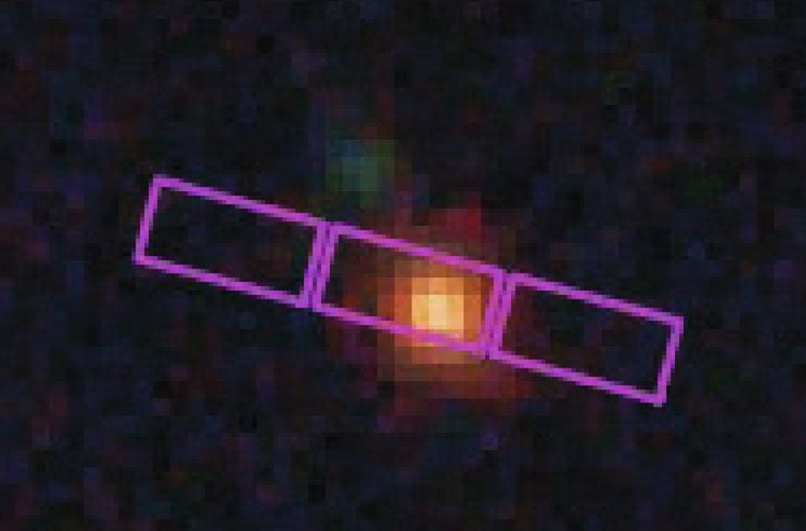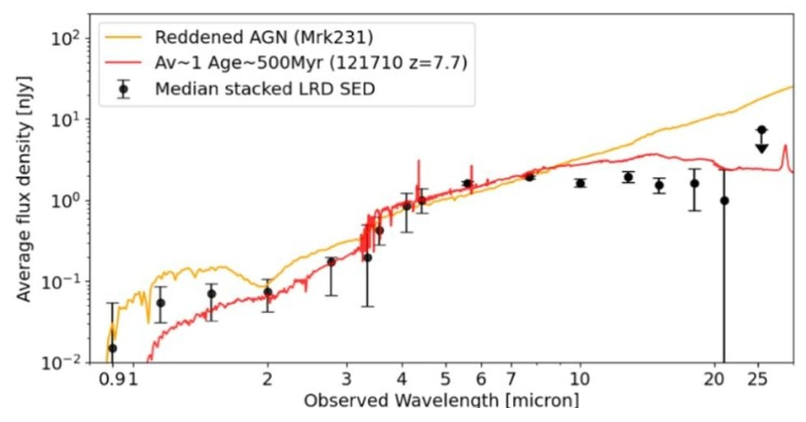When the JWST began science observations in July 2022, it flung open a whole new window on the Universe. The JWST looked further back in time than any other telescope, and it revealed several surprises.
One of them was the Little Red Dots (LRD); ancient, faint objects that the powerful space telescope detected as far back as only 600 million years after the Big Bang.
The JWST found more than 300 LRDs, and their brightness suggested enormous stellar masses. While early thinking suggested they're galaxies, not all agreed, and there were still many questions. There were so many LRDs at such an early time that their existence clashed with our understanding of the early cosmos.
What all scientists do seem to agree on is that these objects are quintessential to understanding the growth and evolution of the Universe into what we see today.
Related: Pushing Webb to Its Limits May Have Revealed Earliest Galaxies

Initial study showed that the LRDs are active galactic nuclei (AGN) with supermassive black holes (SMBH) in their centers. This can explain their distinct red colour, likely caused by enormous amounts of gas and dust surrounding the objects as accretion disks.
But in other respects, they don't resemble AGN. They emit no detectable x-rays, have a flat spectrum in the infrared, and show very little variability.

New research suggests that the LRDs are not actually galaxies, but instead a type of hypothesized star called Supermassive Stars (SMS). Astronomers think that SMS are critical intermediate stages in the formation of SMBH seeds. These SMBHs power the quasars that scientists have observed in the early Universe.
The research is "Supermassive Stars Match the Spectral Signatures of JWST's Little Red Dots." The authors are Devesh Nandal from the Department of Astronomy at the University of Virginia, and Abraham Loeb from the Harvard and Smithsonian Center for Astrophysics. The research is available at arxiv.org.
"The James Webb Space Telescope (JWST) has unveiled a population of enigmatic, compact sources at high redshift known as "Little Red Dots" (LRDs), whose physical nature remains a subject of intense debate," the authors write.
"Concurrently, the rapid assembly of the first supermassive black holes (SMBHs) requires the formation of heavy seeds, for which supermassive stars (SMSs) are leading theoretical progenitors."
The researchers set out to quantitatively test the hypothesis that the LRDs are in fact primordial SMS.

SMS are thought to have around 106 solar masses. The idea is that these stars could only form in the early Universe, and that they exploded as core-collapse supernova that created early black holes that became seeds for SMBH. They can explain why researchers find SMBHs so early in cosmic time, long before they should exist according to current theories.
"LRDs may represent the direct photospheric light of accreting SMS caught in the final ≲ 103 yr before collapse," the authors write. "This short lifetime is consistent with the rarity of LRDs, suggesting they are a fleeting but crucial phase in galaxy and black hole formation."
The researchers developed detailed atmospheric models for an SMS with 106 solar masses and no metals. Since these stars are Population 3 stars, there should be contain no metals. Their model was able to account for the observed characteristics of LRDs.
The simulated SMS matched the luminosity of LRDs, and the spectral features also matched. This is critical, because, as the authors explain, "The ultimate test of our model is its ability to reproduce the observed spectra of LRDs." For their work, they focused on two LRDs called MoM-BH*-1 and The Cliff, objects that feature prominently in scientific literature.
"A defining characteristic of the LRD spectra is the simultaneous presence of a strong, broad Hβ emission line alongside other Balmer lines in absorption," the authors explain. They say that these are caused by the extended dense photosphere around SMSs.
Nandal and Loeb say that their work is "a first-principles investigation into whether Population III supermassive stars (SMSs) can serve as the central engines for the enigmatic class of objects known as Little Red Dots (LRDs)."
They've shown that SMS with 106 solar masses match the luminosity of LRDs. They've shown that an extended stellar photosphere around the SMS can account for the V-shaped Balmer break seen in LRDs. They've also shown that SMS spectra match the observed spectra of LRDs.
"In conclusion, our SMS model provides a remarkably simple and self-consistent physical picture for LRDs," the authors write. While other models showing that LRDs are active galactic nuclei require separate components for emission, absorption, and continuum, theirs presents a unified origin. This is in line with Occam's Razor, which urges us to search for explanations with the smallest number of elements.
While one study doesn't prove anything outright, this one lays the groundwork for deeper research. "Future work should aim to build upon the foundation laid here," the researchers write in their conclusion. Expanded models could explore whether or not their are different pathways for SMS with different masses and other properties to form the observed LRD population.
The Little Red Dots are extremely difficult to observe and are at the edge of the JWST's capabilities. While there may be a more powerful successor to the JWST one day, for now, scientists have to work with what they've got.
If it is proven that the Little Red Dot galaxies aren't galaxies at all, but are instead supermassive stars that are the progenitors of today's supermassive black holes (SMBH), we will have an answer to one of the most compelling questions in astronomy. Scientists can continue to make the case that LRDs are actually SMS, but they may not be able to confirm until well into the future.
This article was originally published by Universe Today. Read the original article.
